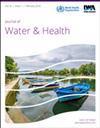水处理前后17β-雌二醇、双酚a和咖啡因浓度水平的比较
IF 2.5
4区 环境科学与生态学
Q3 ENVIRONMENTAL SCIENCES
引用次数: 0
摘要
摘要:本文比较了饮用水来源巴西西诺斯河中17β-雌二醇(E2)、双酚a (BPA)和咖啡因(CAF)的浓度水平与城市水处理厂(WTP)常规处理后污染物的存在。总共开展了9次抽样活动,除饮用水抽样外,还在西诺斯河、WTP的上游和下游采集了样本。采用固相萃取(SPE)法提取样品,液相色谱-质谱联用(LC-MS)法测定样品浓度。在Sinos河中E2、BPA和CAF的最大浓度分别为6127.99 ng·L−1、3294.63 ng·L−1和121.95 ng·L−1。在饮用水中,E2、BPA和CAF的浓度范围分别从小于检测限(LOD)至437.50 ng·L−1、2573.34 ng·L−1和832.30 ng·L−1。总之,西诺斯河中这些污染物的浓度很高,这可能对这一水源产生不利的环境影响。饮用水表明需要一种新的处理方法来促进这些化合物的去除。本文章由计算机程序翻译,如有差异,请以英文原文为准。
Comparison of 17β-estradiol, bisphenol-A and caffeine concentration levels before and after the water treatment plant
Abstract This article compares the concentration levels of 17β-estradiol (E2), bisphenol-A (BPA) and caffeine (CAF) in the Sinos River – Brazil, which is a source of drinking water and the presence of contaminants after the conventional treatment in a municipal water treatment plant (WTP). A total of nine sampling campaigns were carried out, with sample collection in the Sinos River, upstream and downstream of the WTP, in addition to a drinking water sample (DW). The samples were extracted with solid phase extraction (SPE) and the concentration by liquid chromatography coupled to mass spectrometry (LC-MS). The maximum concentration in the Sinos River was 6,127.99 ng·L−1 for E2, 3,294.63 ng·L−1 for BPA and 1,221.95 ng·L−1 for CAF. In drinking water, the concentration range of E2, BPA and CAF was from less than the limit of detection (LOD) up to 437.50 ng·L−1, <LOD up to 2,573.34 ng·L−1 and <LOD up to 832.30 ng·L−1, respectively. In conclusion, the concentrations of these pollutants present in the Sinos River are high, which may represent a negative environmental impact on this water source. Drinking water indicates the need for a new treatment process that could promote the removal of these compounds.
求助全文
通过发布文献求助,成功后即可免费获取论文全文。
去求助
来源期刊

Journal of water and health
环境科学-环境科学
CiteScore
3.60
自引率
8.70%
发文量
110
审稿时长
18-36 weeks
期刊介绍:
Journal of Water and Health is a peer-reviewed journal devoted to the dissemination of information on the health implications and control of waterborne microorganisms and chemical substances in the broadest sense for developing and developed countries worldwide. This is to include microbial toxins, chemical quality and the aesthetic qualities of water.
 求助内容:
求助内容: 应助结果提醒方式:
应助结果提醒方式:


